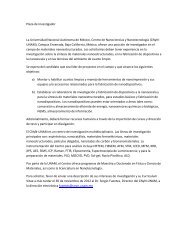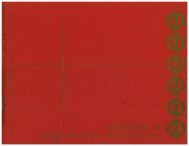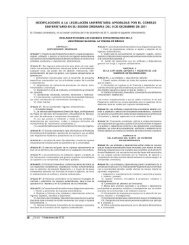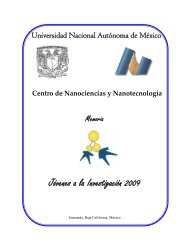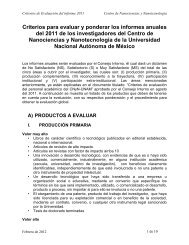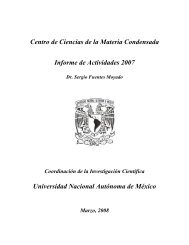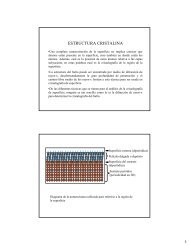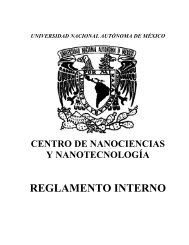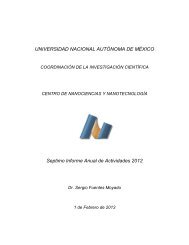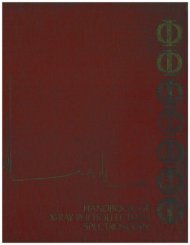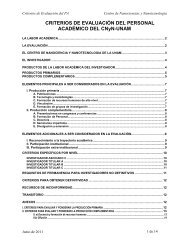Universidad Nacional Autónoma de México - CNyN
Universidad Nacional Autónoma de México - CNyN
Universidad Nacional Autónoma de México - CNyN
Create successful ePaper yourself
Turn your PDF publications into a flip-book with our unique Google optimized e-Paper software.
1st International Symposium on Nanoscience and Nanomaterials<br />
3 <strong>Universidad</strong> <strong>Nacional</strong> Autónoma <strong>de</strong> México, Centro <strong>de</strong> Nanociencia y Nanotecnología, km.107 carr. Tijuana<br />
- Ensenada, Ensenada, B.C., México.<br />
4 <strong>Universidad</strong>e Fe<strong>de</strong>ral <strong>de</strong> Minas Gerais, 31270-901 Belo Horizonte, MG, Brazil.<br />
a mestrada@cicese.edu.mx, b eunicev@uabc.edu.mx, c elena@cnyn.unam.mx, e, f elena@ufmg.br,<br />
g fuentes@cnyn.unam.mx, h andrey@cnyn.unam.mx.<br />
Keywords: gold nanoparticles, primary alcohols, aerobic oxidation.<br />
Metal catalyzed oxidations of alcohols which involve O 2 as a final oxidant, currently attract much<br />
attention due to the low cost of oxygen as a “green oxidant”. Gold nanoparticles (NPs) being among the most<br />
promising catalysts for these reactions. Au(3 wt.%)/MgO catalyst used for activity test has been prepared by<br />
the <strong>de</strong>position-precipitation technique. Fresh and spent samples were characterized by UV-Vis in situ and<br />
TEM. It was revealed that Au/MgO is an effective catalyst for the liquid-phase oxidation of a wi<strong>de</strong> range of<br />
alcohols (1-phenylpropanol, Nerol, perillyl alcohol, isoborneol, carveol, menthol, isopulegol, and citronellol)<br />
using O 2 as sole oxidant in the absence of any co-catalyst or additive. The authors thank to E. Flores, P.<br />
Casillas, V. García, F. Ruiz, E. Aparicio, M. Sainz, J. Palomares and J. Peralta for their kind technical support<br />
in this work. This project was supported by DGAPA–PAPIIT (UNAM, Mexico) through grant 224510.<br />
P-006<br />
GOLD SPECIES WITH DIFFERENT SIZE STABILIZED ON NANOSTRUCTURED ALUMINA<br />
M. López 1a , E. Smolentseva 2b , M. A. Estrada 3c , E. Vargas 4d , B. Acosta 3e , A. Simakov 2f .<br />
1 Posgrado en Ciencias e Ingeniería <strong>de</strong> Materiales UNAM Km. 107 Carr. Tijuana Ensenada 22860 Ensenada,<br />
B.C., México<br />
2 <strong>Universidad</strong> <strong>Nacional</strong> Autónoma <strong>de</strong> México, Centro <strong>de</strong> Nanociencias y Nanotecnología, km.107 Carr.<br />
Tijuana –Ensenada 22860, Ensenada, B.C., México.<br />
3 Posgrado en Física <strong>de</strong> Materiales, Centro <strong>de</strong> Investigación Científica y <strong>de</strong> Educación Superior <strong>de</strong> Ensenada,<br />
Carr. Tijuana-Ensenada No. 3918 Fraccionamiento Zona Playitas, C.P. 22860 Ensenada, B.C., México.<br />
4 Posgrado en Ciencias e Ingeniería, Área Nanotecnología, <strong>Universidad</strong> Autónoma <strong>de</strong> Baja California km.103<br />
Carr. Tijuana –Ensenada 22860, Ensenada, B.C., México.<br />
a<br />
Martinlopez_360 @hotmail.com, b elena@cnyn.unam.mx, c mestrda@cnyn.unam.mx,<br />
d evargas@cnyn.unam.mx, e bacosta@cnyn.unam.mx. f andrey@cnyn.unam.mx<br />
Keywords: nanoparticles, gold, in-situ, nanostructured alumina.<br />
Catalytic properties of supported gold species in the practically important reactions of environmental<br />
and fine chemistry are <strong>de</strong>termined by the size of these species. The present work was <strong>de</strong>dicated to the study of<br />
dynamic formation of gold nanoparticles with different size over nanostructured alumina prepared by sol gel<br />
technique using organo-metallic precursors. The appearance and sintering of gold species was monitored by<br />
Mass-UV-Vis-In Situ technique consisting in the combination of high temperature fiber optic UV-Vis<br />
spectrometer and simultaneous in line analysis of gas phase products with mass-spectrometer. The shape and<br />
size of obtained gold species in the ready samples were characterized with TEM. Analysis of the steps of gold<br />
nanoparticles formation resulted in the fabrication of Au/Al 2 O 3 samples with <strong>de</strong>finite size and morphology of<br />
the gold species. The authors thank E. Flores, F. Ruiz, J.A. Peralta, J. Palomares and O. Callejas for their<br />
technical assistance. This research project was financially supported by DGAPA–PAPIIT through Grant IN<br />
224510.<br />
26




